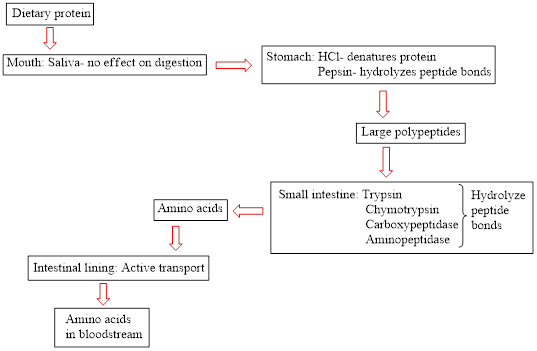
Concept explainers
(a)
Interpretation: To identify whether the statement “gastrin is a hormone released by stomach mucosa cells” relating to protein digestion is true or false.
Concept introduction: Proteins are natural biopolymers. Amino acids are the main building block of protein molecules. A large number of amino acids condense together to form a polypeptide chain. A large polypeptide chain is called protein. The digestion of dietary protein starts in the stomach and is completed in the small intestine. It does not start in the mouth because saliva present in the mouth does not contain an effective enzyme to break down the protein. The flow chart for protein digestion in the human body is as follows:

(b)
Interpretation: To identify whether the statement “approximately
Concept introduction: Proteins are natural biopolymers. Amino acids are the main building block of protein molecules. A large number of amino acids condense together to form a polypeptide chain. A large polypeptide chain is called protein. The digestion of dietary protein starts in the stomach and is completed in the small intestine. It does not start in the mouth because saliva present in the mouth does not contain an effective enzyme to break down the protein. The flow chart for protein digestion in the human body is as follows:

(c)
Interpretation: To identify whether the statement “hydrochloric acid functions as a denaturing agent in the stomach” relating to protein digestion is true or false.
Concept introduction: Proteins are natural biopolymers. Amino acids are the main building block of protein molecules. A large number of amino acids condense together to form a polypeptide chain. A large polypeptide chain is called protein. The digestion of dietary protein starts in the stomach and is completed in the small intestine. It does not start in the mouth because saliva present in the mouth does not contain an effective enzyme to break down the protein. The flow chart for protein digestion in the human body is as follows:

(d)
Interpretation: To identify whether the statement “pancreatic digestive enzymes include carboxypeptidase and aminopeptidase” relating to protein digestion is true or false.
Concept introduction: Proteins are natural biopolymers. Amino acids are the main building block of protein molecules. A large number of amino acids condense together to form a polypeptide chain. A large polypeptide chain is called protein. The digestion of dietary protein starts in the stomach and is completed in the small intestine. It does not start in the mouth because saliva present in the mouth does not contain an effective enzyme to break down the protein.
The flow chart for protein digestion in the human body is as follows:

Trending nowThis is a popular solution!

Chapter 15 Solutions
Organic And Biological Chemistry
- How does the square root mean square velocity of gas molecules vary with temperature? Illustrate this relationship by plotting the square root mean square velocity of N2 molecules as a function of temperature from T=100 K to T=300 K.arrow_forwardDraw product B, indicating what type of reaction occurs. F3C CF3 NH2 Me O .N. + B OMearrow_forwardBenzimidazole E. State its formula. sState the differences in the formula with other benzimidazoles.arrow_forward
- Draw product A, indicating what type of reaction occurs. F3C CN CF3 K2CO3, DMSO, H₂O2 Aarrow_forward19) Which metal is most commonly used in galvanization to protect steel structures from oxidation? Lead a. b. Tin C. Nickel d. Zinc 20) The following molecule is an example of a: R₁ R2- -N-R3 a. Secondary amine b. Secondary amide c. Tertiary amine d. Tertiary amidearrow_forwardpls helparrow_forward
- pls helparrow_forward35) Complete the following equation by drawing the line the structure of the products that are formed. Please note that in some cases more than one product is possible. You must draw all possible products to recive full marks! a. ethanol + 2-propanol + H2SO4 → b. OH conc. H2SO4 CH2 H3C CH + K2Cr2O7 C. d. H3C A pressure CH3 + H2 CH Pt catalystarrow_forward21) The rate of reaction depends upon: a. the concentration and nature of reactants b. the temperature of the reaction C. whether or not a catalyst was used d. all of the above 22) A Maxwell-Boltzmann curve shows the distribution of molecular energies in a reaction system. When the temperature in this system is increased, the peak is a. higher and further to the right. b. higher and further to the left. c. lower and further to the right. d. lower and further to the left. 23) Which of the following correctly describes the reaction represented by the reaction below? CaCO3 (s) + energy → CaO (s) + CO2 (g) a. It is exothermic and the potential energy is greater in the reactants than the products. b. c. It is exothermic and the potential energy is greater in the products than the reactants. It is endothermic and the potential energy is greater in the products than the reactants. d. It is endothermic and the potential energy is equal for the products and reactants.arrow_forward
 Chemistry for Today: General, Organic, and Bioche...ChemistryISBN:9781305960060Author:Spencer L. Seager, Michael R. Slabaugh, Maren S. HansenPublisher:Cengage Learning
Chemistry for Today: General, Organic, and Bioche...ChemistryISBN:9781305960060Author:Spencer L. Seager, Michael R. Slabaugh, Maren S. HansenPublisher:Cengage Learning General, Organic, and Biological ChemistryChemistryISBN:9781285853918Author:H. Stephen StokerPublisher:Cengage Learning
General, Organic, and Biological ChemistryChemistryISBN:9781285853918Author:H. Stephen StokerPublisher:Cengage Learning Organic And Biological ChemistryChemistryISBN:9781305081079Author:STOKER, H. Stephen (howard Stephen)Publisher:Cengage Learning,
Organic And Biological ChemistryChemistryISBN:9781305081079Author:STOKER, H. Stephen (howard Stephen)Publisher:Cengage Learning,
 World of Chemistry, 3rd editionChemistryISBN:9781133109655Author:Steven S. Zumdahl, Susan L. Zumdahl, Donald J. DeCostePublisher:Brooks / Cole / Cengage Learning
World of Chemistry, 3rd editionChemistryISBN:9781133109655Author:Steven S. Zumdahl, Susan L. Zumdahl, Donald J. DeCostePublisher:Brooks / Cole / Cengage Learning Introduction to General, Organic and BiochemistryChemistryISBN:9781285869759Author:Frederick A. Bettelheim, William H. Brown, Mary K. Campbell, Shawn O. Farrell, Omar TorresPublisher:Cengage Learning
Introduction to General, Organic and BiochemistryChemistryISBN:9781285869759Author:Frederick A. Bettelheim, William H. Brown, Mary K. Campbell, Shawn O. Farrell, Omar TorresPublisher:Cengage Learning





